Magura mountain bike brakes - a comprehensive overview
Magura brakes have been part of the MTB landscape since the first clunkers in the mid-1970s, here is everything you need to know about Magura's brake range
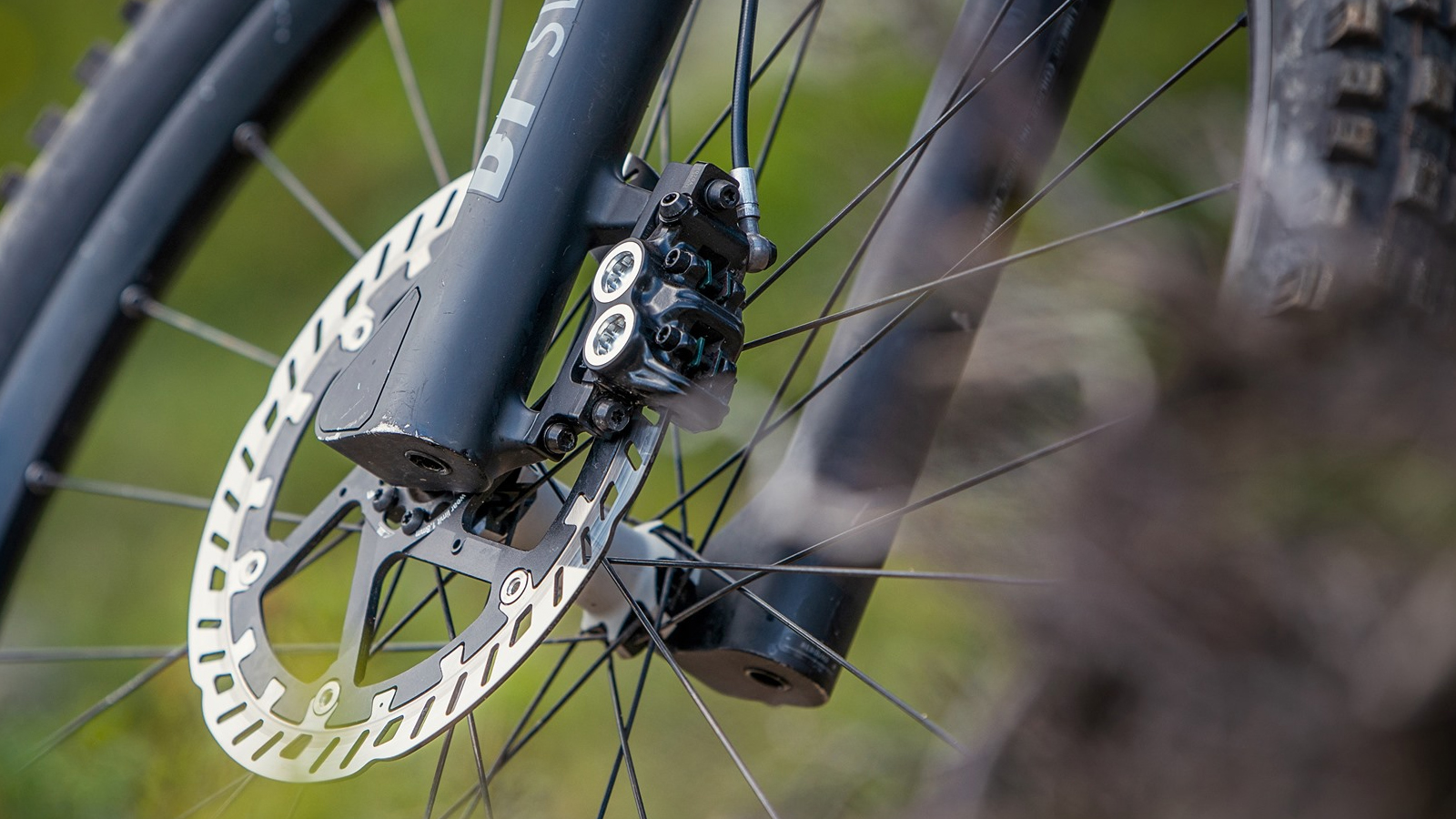
Few component companies have the depth of two-wheeled history that Magura does. It has been making brakes for pedaled and powered bikes since 1893. It was also the first company to give credit to Gary Fisher’s Mountain Bikes startup when he was using Magura's four-finger motorbike levers.
A decade later and the German hydraulic and composite specialist totally changed the MTB stopping landscape, creating the best mountain bike brakes of its era with the super-powerful HS series hydraulic rim brakes that are still going strong over 30 years later. It was an early pioneer of disc brakes, and thanks to the massive power of its four-piston calipers and automotive links with Bosch, its disc brakes are appearing on loads of e-bikes now too. Top riders like YouTube trials legend Danny MacAskill and Loic Bruni are long-term Magura users too.
Magura has always taken a very independent approach to design, materials and operating feel throughout its history and that’s no different today. It also has a much bigger range of buzzwords and upgrade options than most brands too. So what do you need to know to find the right Magura brakes for you? Skip to Magura tech explained for all the information you need otherwise scroll down to see Bike Perfect's roundup of Magura's range of brakes.
Magura mountain bike brakes range
Why trust BikePerfect
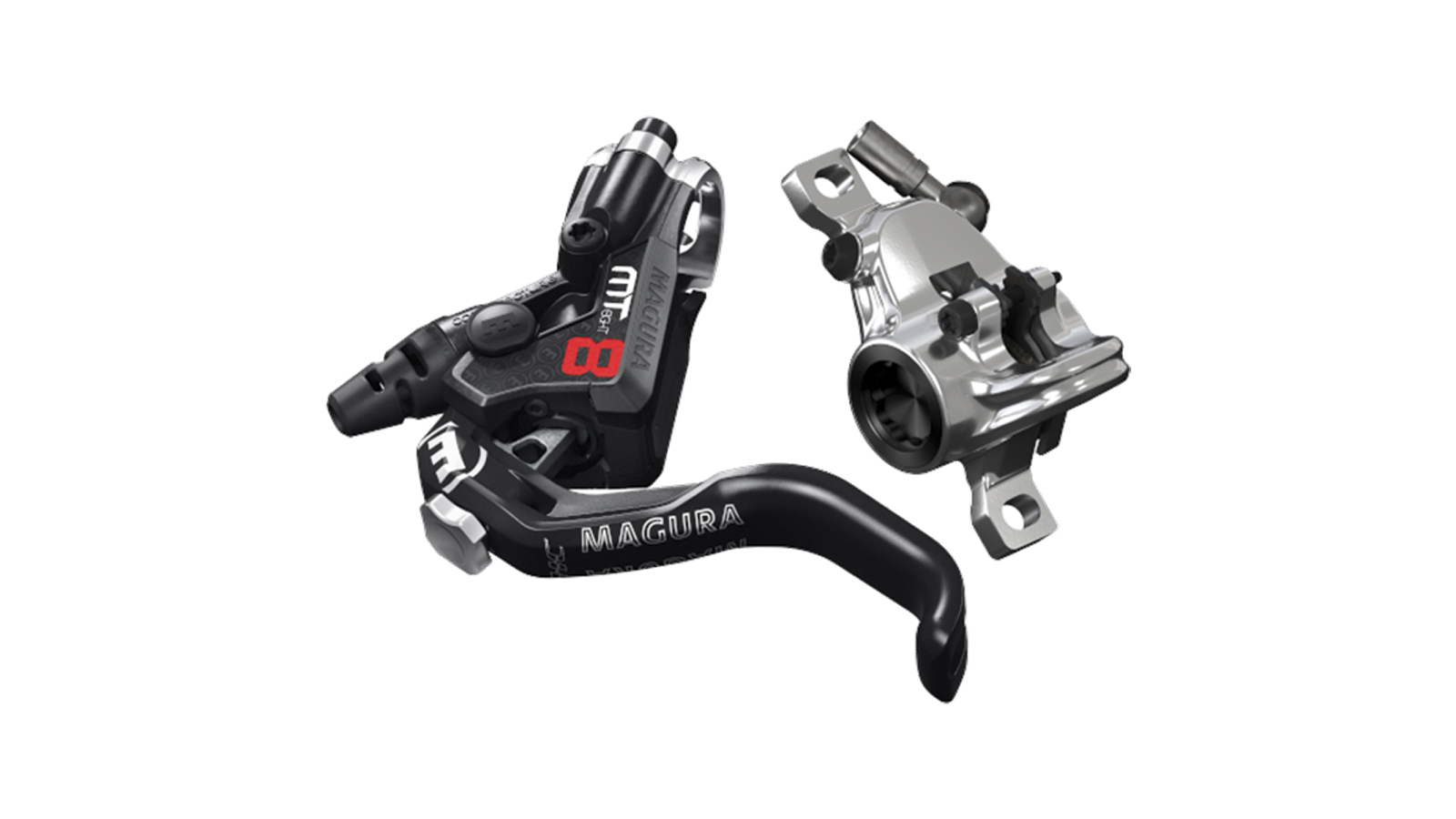
MT8
Specifications
Reasons to buy
Reasons to avoid
According to Magura, its flagship superlight brake isn’t just for XC racers, but it’s the headset cap removing, stem flipping, skin suit wearers who are going to be most excited by the claimed sub 200g weight of the SL with its minimalist one finger carbon lever. The Pro uses the same Carbotecture SL master body but with an alloy lever featuring a reach adjust dial (SL uses a 3mm Allen key) which adds 30g but knocks €100 off the price.
Both brakes use the same tiny twin-cylinder, single-piece forged caliper that’s also available in a flat-mount version. Add the lightweight Storm SL.2 rotor with power levels comparable to most single pot XC/Trail brakes. Modulation and feel are typically Magura, with a hard bite and then softer stroke as the body flexes. Thorough bedding in is also crucial to get the best performance.
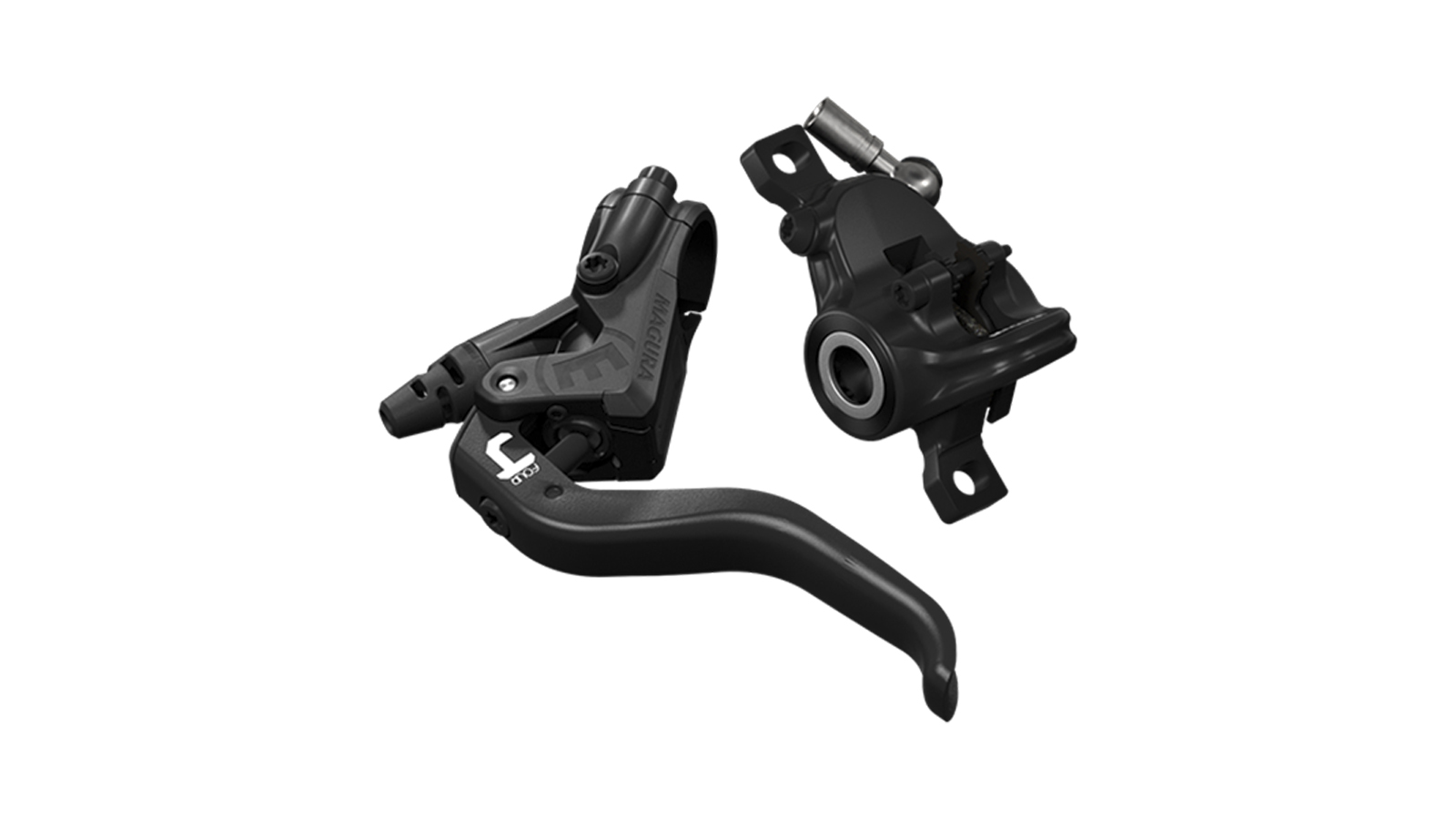
MT4
Specifications
Reasons to buy
Reasons to avoid
A real bargain brake for riders who still want performance, MT4 packs all the features you need into a brake that’s light (230g claimed) on your bike and light on your wallet. The Carbotecture master cylinder body is very similar to the 8 but with a simpler alloy lever. You can upgrade it with any of the aftermarket Magura lever options if you want though. You still get a T25 wrench adjustable lever reach and an ambidextrous flip flop design too and the lever feel is essentially the same. The caliper is the same single-piece, twin-piston unit too so you get reasonable power with the characteristic Magura hard bite then soft squeeze feel. Adjustable hose angle ‘banjo’ and a flat-mount caliper option make for neat installation on all bikes too. Pricing is also very good although the MT Sport has rained on its parade slightly if you’re really skint.
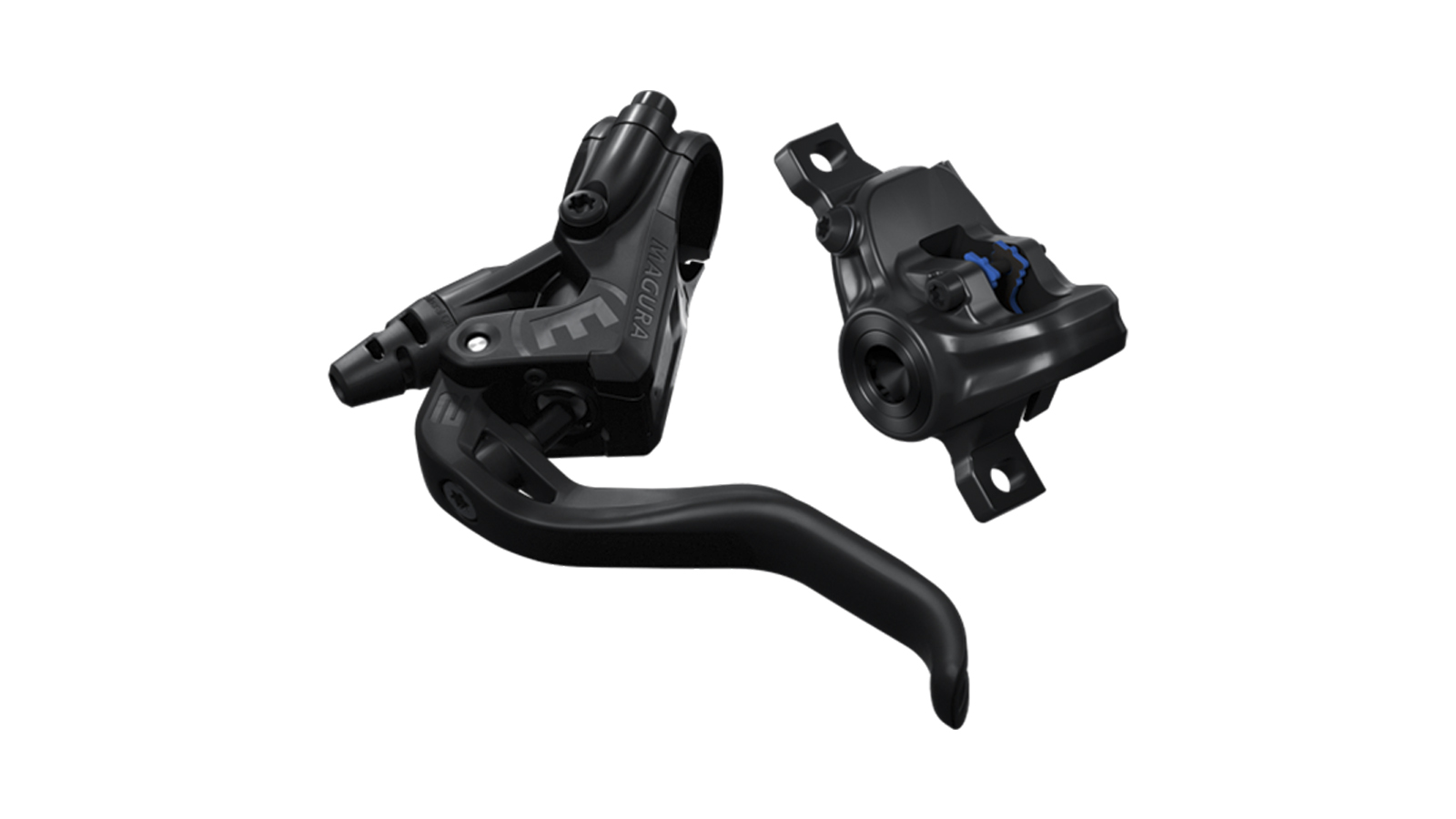
MT Sport
Specifications
Reasons to buy
Reasons to avoid
MT Sport is the cheapest brake from Magura and a great upgrade compared to numb budget hydraulic discs and cable-operated systems. The Carbotecture lever body and caliper are the same as the MT4 so it’s still light for a budget brake at 245g claimed. It’s ambidextrous, combined shifter clamp compatible and you can adjust reach with a Torx key. The lever is Carbotecture though which makes for a softer, less accurate brake feel than the alloy blade on the MT4. The spongier sensation is still easier to modulate and much less likely to cause arm pump than most horribly wooden feeling brakes of a similar price. Plus if it really bothers you, just pick a blade from Magura’s extensive upgrade range. The fixed hose position can look awkward on some installations but there’s no downgrade in pad or pipe either so underlying power is still reasonable.
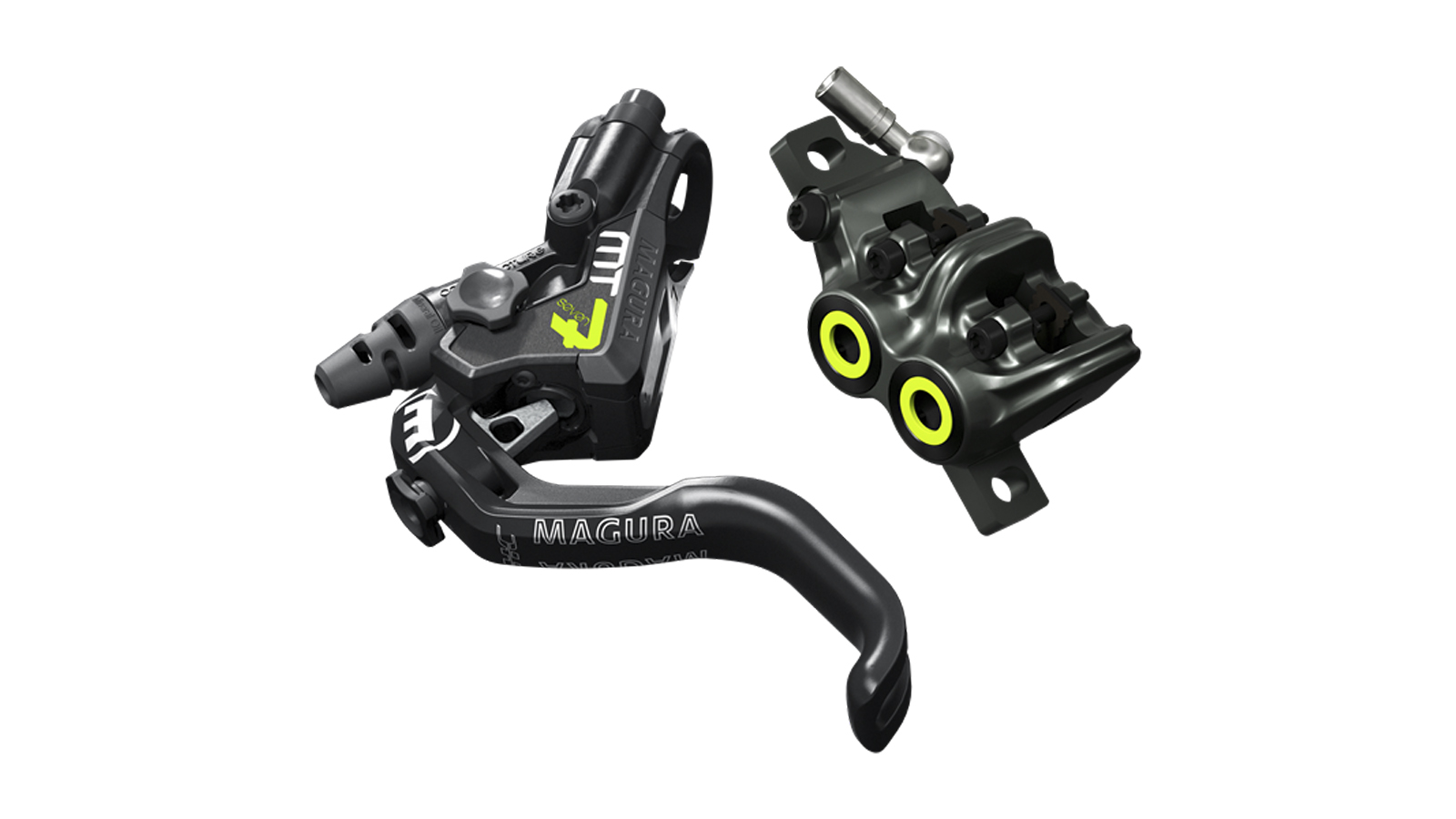
MT7
Specifications
Reasons to buy
Reasons to avoid
Thanks to their super-stiff Triple Arch calipers, Magura’s four-cylinder stoppers are the most powerful brakes we’ve tested on a dyno. Their dramatic initial bite makes them feel even more pokey on the trail. Add the 220mm MDR-P E-bike rotors and even with a single finger lever, you’ll turn your bike into a rider flinging siege engine if you’re not careful. While there’s still obvious lever body flex from the Carbotecture SL construction the forged lever is the stiffest in the Magura collection so modulation is consistent once you’re used to the basic feel. Bite point and reach can be tuned via small dials on the lever and you can swap the levers themselves if you want. You can also re-decorate your brake with lever body and piston ring kits in various colors. The brakes are ambidextrous, work with combined shifter and suspension remote mounts, and overall weight is mid-pack despite the exceptional power.
The Carbotecture construction is more prone to crash damage than metal brakes though and we’ve had a glitch with the levers disconnecting from the piston on a recent set (you can hack them back together with a thin zip tie or wire). They need thorough bedding-in not to eat their pads extremely quickly too. That’s particularly important as the single pads over each piston can fall out of their guide slots if they get too worn, which completely seizes the wheel. That means we’d definitely recommend the longer ‘double piston’ pads as a replacement even if they don’t come in the high-performance ‘R’ race option. If you’re not bothered about bite point adjust and don’t have small hands, the MT5s are much better value, too.

MT5
Specifications
Reasons to buy
Reasons to avoid
The MT5 takes the molded thermoplastic Carbotecture body and simple alloy blade from the MT4 and connects it to the single-piece, Triple Arch 4 cylinder caliper of the MT7. The result is a huge amount of power which only Shimano’s old Saint and Zee brakes coming close to the same stopping numbers on the dyno. That’ll stand even the heaviest e-MTB or runaway DH bike on its nose with just one finger for just over $139 making them a gift for aggro anchor fans on a budget.
Lack of position adjustment for the very strong initial bite means they need more care than the MT7s until you’re used to them. Riders who like their brakes to come on just shy of the grips should look elsewhere too and they certainly don’t suit small hands. There’s still obvious sponginess from the composite body if you pull harder further into the stroke and the lever blade wobbles a bit more than MT7 after a while too. You can still choose from the full range of Magura lever blade, color kit, mixed mount and rotor upgrade arsenal though. Like all Magura brakes, it's also powered by relatively eco-friendly and skin/paint harmless ‘Royal Blood’. Be sure to bed them in properly to stop the pads from vanishing in a few rides in dirty conditions. Keep checking wear levels on the separate pads as they can jam the rotor with potentially very painful results if they get too worn and come out of their guide slots.
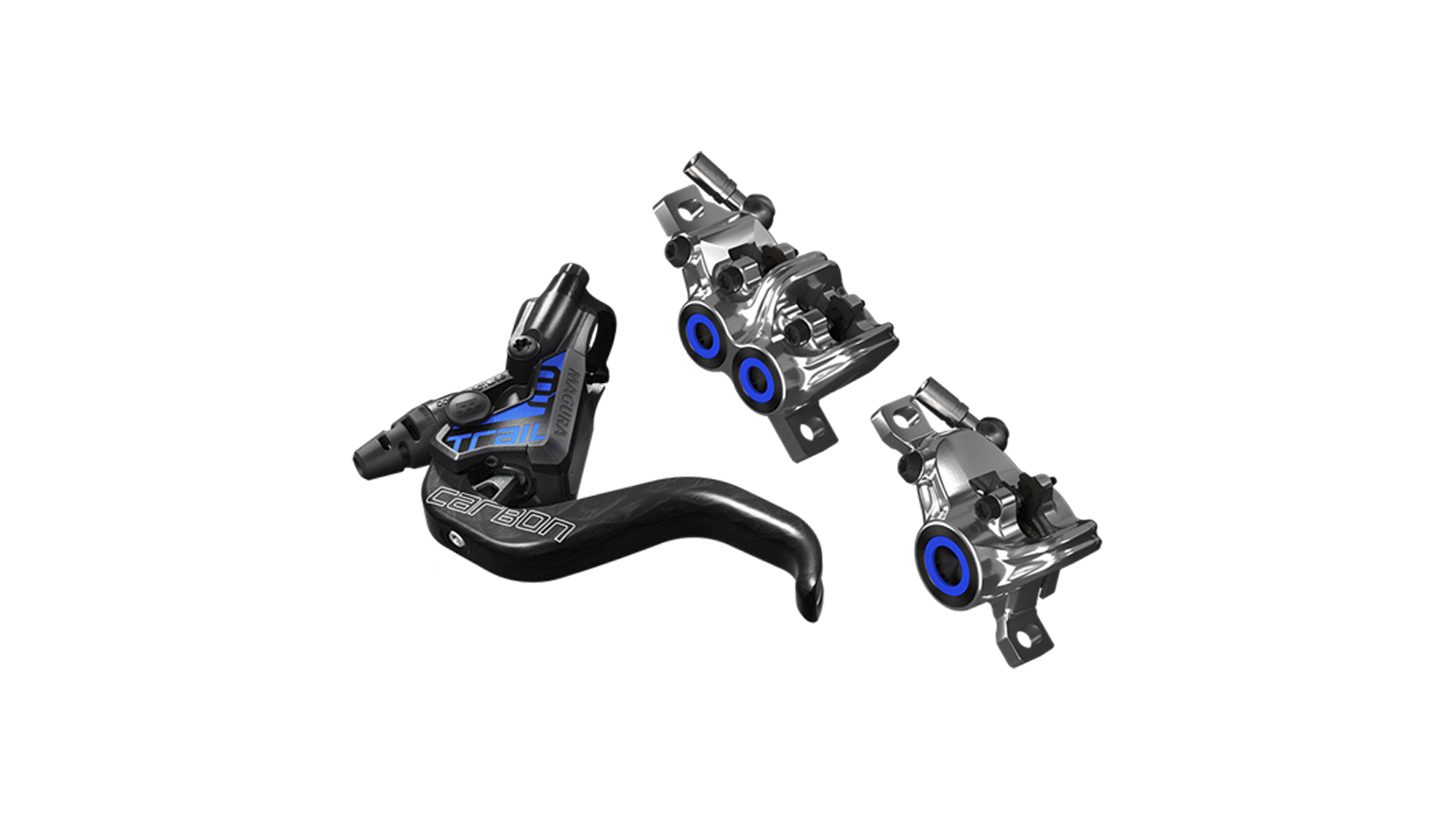
MT Trail SL
Specifications
Reasons to buy
Reasons to avoid
Magura’s motorbike heritage is clear in their MT Trail combo sets which use a 4 cylinder caliper at the front and a 2 cylinder caliper at the rear. The idea is that gives you maximum stopping power on the front where there’s most grip and it can do the most good. Then you have less power but more modulation on the rear where you’re more likely to skid. The SL is the flagship pairing that matches an MT7 front caliper with an MT8 rear and then attaches them to superlight, carbon MT8 levers. They also polish the calipers up all shiny and use special blue reservoir covers and cylinder caps which makes them look a lot neater than running two different brakes. The result is 60g heavier and $21 more than a pair of MT8s but with a lot more power. Or 60g lighter but $121 more than a pair of MT7 Pro's with less skidding.
If you’re not after extreme power or extreme low weight the front and rear pairing works really well too. It naturally levels off the results of lever pull to the point where you might actually have to relearn your lopsided hardwired braking responses slightly.
All the usual Magura caveats of thorough bedding in and regular pad checking apply - particularly on the front - though and the MT Trail Sport offers the same basic performance just without bite point adjust or polished calipers for a very significant $320.00 less.

MT Trail Sport
Specifications
Reasons to buy
Reasons to avoid
The Sport version of the MT Trail concept matches an MT5 four-cylinder front brake with an MT4 two-cylinder rear brake and then adds HC 1 finger forged alloy lever blades. The result is huge amounts of power up front - where most of the grip is - and then better control at the back tire for reducing skids. It naturally works really well too, although riders who are hardwired to pull the back brake less and the front more might have to relearn their habits to stay on the right side of their handlebars. The lack of bite point adjust is less critical as the new blades are a lot more small finger/short reach friendly.
The Magura lever feel/power delivery won’t suit everyone though and the usual warnings about thorough bedding in and regular pad checking apply. You could also buy an MT7 for $139.00 and an MT4 for $119.00 and save yourself $21.00 without things looking obviously wonky at the bars.
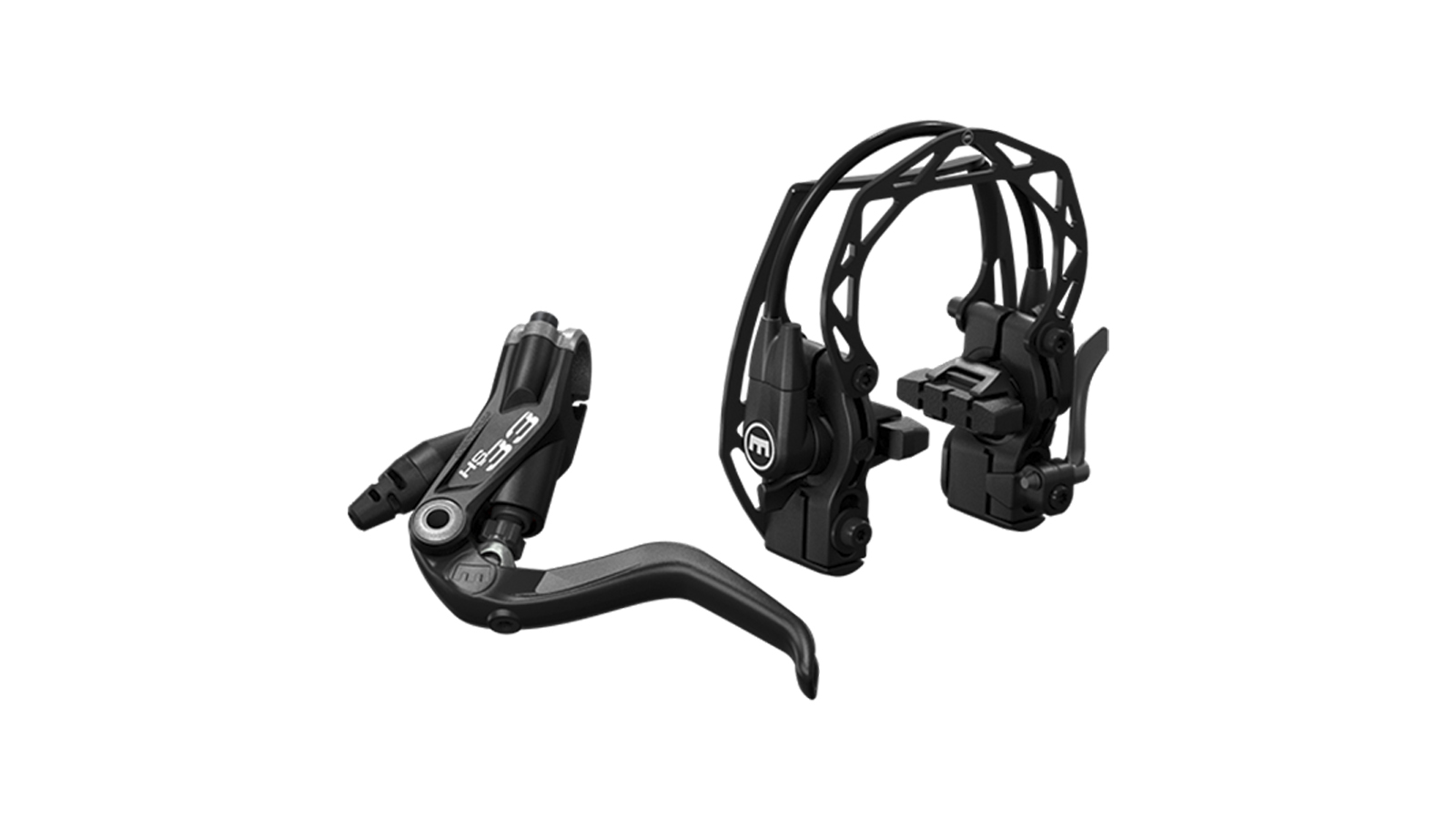
HS33
Specifications
Reasons to buy
Reasons to avoid
Gary Fisher might have fitted Magura motorbike levers to his first MountainBikes but the HS rim brakes were the German firm's really revolutionary entry to the MTB market. They’ve only changed slightly in over 30 years too. They still work on the wheel rim, not a central rotor and fit frames/forks with cantilever studs. That means they need a slightly awkward quick release so you can remove them to get your wheel in/out when inflated. A cross brace is also crucial to stop the brakes just twisting the frame/fork apart and the HS33 actually gets two for maximum power and accuracy ($135.00 HS22 just gets one as well as a three-finger lever). The brake pads - in four different compounds from maximum power to maximum lifespan - are a unique click fit design, too.
The updated levers do fit combined shifter/remote mounts though. With the super direct hydraulic feel and the rim itself creating the biggest braking leverage possible, the HS33s are hugely powerful and - presuming the rim is clean and dry - instantly reactive. That’s why they’re still very popular among trials riding specialists who need an immediate, very strong lock to hop around with. If you’re still running a rim-braked bike for general use then power and feedback are significantly better than cable-operated V brakes too. Rim wear is accelerated though and performance drops off dramatically if the rims get wet or dirty, but if you don’t want discs these are your best option.
Magura tech explained
Magura definitely doesn’t follow the herd when it comes to brake design. That means there’s plenty of tech in its range that needs a bit of explaining. Like most brands, it also has fancy names for some more common stuff, but hey, ‘Royal Blood’ sounds way more exciting than ‘mineral oil’ right?
1. Magura feel
While it’s not a specific piece of tech, it’s definitely worth pointing out that Magura brakes tend to have a noticeably different feel.
Part of that comes from the radial design which puts the reservoir perpendicular with the bars but means the lever curves in noticeably as you pull. That means you need to wind out the reach adjustment a long way to put the brake in its power sweet spot which won’t suit smaller hands. Stiff calipers and the inherent leverage ratios of the design mean initial contact is often very direct too. This can feel jerkingly abrupt if you’re not used to it - particularly as Magura’s four-pot brakes are also extremely powerful. It’s that grabby, high feedback response that’s always made them very popular with trials riders though. Depending on the amount of flex in the composite lever body and the blade design, the brake feel can then soften as you pull harder. Again some people like this, some don’t - but it’s worth being aware of before hitting your first technical descent.
2. Living with Magura brakes
Magura offers a range of different aftermarket pads: P all-rounders, C for lower heat and softer bite, and R for maximum bite although suffer from increased heat build-up. Not all pad types are available for all brakes. We’ve always found that Magura brakes need more prolonged and methodical bedding in procedure than most brakes to get full performance and lifespan too.
It’s also worth checking the master cylinder (lever body) on Magura brakes after crashing. The Carbotecture construction is more fragile than metal brakes and we’ve had instances where they’ve cracked without us realizing and then snapped/split completely when we’ve pulled the levers later.
3. Carbotecture
Magura has its own in-house injection molding facility and huge experience in making molded auto and motorcycle parts. Carbotecture is the super light, carbon fiber infused, injection-molded high-density thermoplastic used for their master cylinder bodies. CarbonFlow is the name they use for the molding process.
4. Carbolay
Carbonlay pieces (generally the brake levers and clamps on top models) use high-density fiber woven sheets with carbon fiber strands ‘embroidered’ into them to increase strength.
5. Pro levers
Magura produces a range of upgrade levers varying from super light carbon single finger setups (HC1 Carbon) through monster four finger blades to the multi-piece HC3 alloy lever which has built-in dials for reach, blade kink and even leverage/power.
6. Flip Flop
All Magura levers can be run either way up so you can swap front/rear brakes left/right without needing to detach hoses and re-bleed, it also makes sourcing replacement levers much easier.
7. Royal Blood
Royal Blood is Magura’s proprietary blend of low viscosity mineral oil. It used to be pinky red, but changed in 2002 to a blue color which actually makes more sense given that the aristocracy is often described as having ‘blue blood’.
8. Storm rotors
While most brands offer one or two different designs, Magura has a whole range of rotors through the super light STORM SL.2, through the general-purpose STORM HC to the MDR-P E-Bike Optimised rotor. This uses a two-piece steel outer, alloy inner design dovetailed and riveted together to allow slight float and heat expansion in the most extreme situations. It comes in a massive 220mm diameter for maximum stopping power too.
9. Magnetixchange
Some of Magura’s brakes use magnetized cylinders and pad plates to hold the pads in place saving the sometimes fiddly process of fitting pads that sit within holders.
10. Triple Arch
Magura’s four-cylinder brakes are forged with an extra central bridge between the inboard and outboard halves to increase caliper stiffness.
11. Easy Bleed
Magura’s bleeding process isn’t hard, but we wouldn’t say it was any easier than most. Caliper ports at the near end of the caliper mean it’s certainly not as easy as the full flush through of SRAM’s Bleeding Edge tech.
12. Rings and covers
The colored brake master covers on Carbotecture SL brakes (MT6, MT7, MT8 and MT Trail SL) can be swapped to different designs. The rings around the caliper cylinder heads can also be swapped with three colors in each packs ranging from gold to neon pink.
13. Wood screws
OK we know they’re not actually wood screws, but rather than normal bolts, the bar clamps are secured with tapered screws threaded into the composite body. Don’t worry they work fine even if you adjust them regularly and they’re easy to replace from a DIY store in an emergency. We just wanted to warn you in case you thought your Magura had been corrupted by a carpenter.
14. Bosch eBike ABS
Magura is working very closely with Bosch these days and one of the most interesting pieces of kit is their ABS system for Ebikes. This ‘senses’ rear wheel lift under extreme braking and automatically modulates front brake power to keep both wheels on the ground and stop you from going over the bars. We’ve not actually used it, as it’s currently aimed at urban rather than MTB use but it’ll be interesting to see where it goes.

Guy Kesteven has been working on Bike Perfect since its launch in 2019. He started writing and testing for bike mags in 1996. Since then he’s written several million words about several thousand test bikes and a ridiculous amount of riding gear. He’s also penned a handful of bike-related books and he reviews MTBs over on YouTube.
Current rides: Cervelo ZFS-5, Specialized Chisel, custom Nicolai enduro tandem, Landescape/Swallow custom gravel tandem
Height: 180cm
Weight: 69kg
